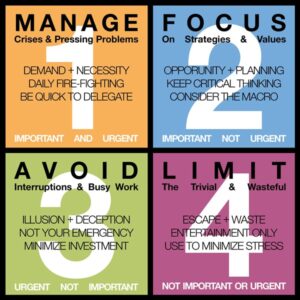I have a project at the office that I am really excited about. It’s a big project that, if successful, could have a great impact on the company. But it’s a long-term project, and it’s brand new, so there is no well-worn path of which to follow.
In other words, it’s important but not urgent.
In addition, I am at the stage of the project where every decision seems like a “forever decision.” It’s the kind of decision, that once you make it, you will operate from that assumption to create everything else. It’s like when at the beginning of your relationships, you decide what side of the bed you are going to sleep on. It turns out, whether you know it or not, that’s forever! This is the kind of work that changes your organization. It’s Deep Work.
And, as you might suspect, I am struggling to make the kind of progress I want on this project. Every day, when I head into the office with this project on my radar and on my to-do list. And every day, the whirlwind of the workday gets in the way. Between emails, and phone calls, and interruptions, and unintentional time-wasters (yes we all have those), I get to the end of my day and have not made the kind of progress I want.

I need to get to Quadrant 2
In Stephen Covey’s classic book on personal development, The 7 Habits of Highly Effective People, Covey describes the 4 types of activities that encompass every day. All of the activities that we engage in each day fall into one of these quadrants. But as is the case with most things in our life, we are not intentional about them. The quadrants are:
- Important and Urgent
- Important not Urgent
- Urgent, not Important
- Not Important or Urgent
Obviously, we want to minimize Quadrant 4, especially at work. It is important to have things that allow us to relax, but we are not effective in this space. This is easy.
Quadrant 3 is the trap. That’s because it feels important simply because it’s urgent. It’s an illusion. These are the interruptions at work that keep you from doing the really important tasks.
I am guilty of living in Quadrant 1 at work. It’s easy to do because, as the title suggests, it is both important and urgent. It’s fire fighting. And while it is important, if you are spending all of your time here, it means you are not being pro-active.
We all need to get to Quadrant 2 more often.
This is the most pro-active quadrant that allows us to do important, long-term work. This is the space where we do long-term planning, goal setting, and real creation of value for the organization. It is also the quadrant where I need to spend more time to push my new project forward.
Do you have an important project that is stalled? It’s likely time to get some quality time on your calendar to do some deep work in Quadrant 2.
Make sure you never miss an update! It’s time to become a VIP. Sign up here.
Kirby Hasseman is the CEO of Hasseman Marketing, a full-service marketing agency located in Ohio. Learn more about Hasseman Marketing here. And if you are interested in having him speak at your next event, you can learn more here.

0 Comments